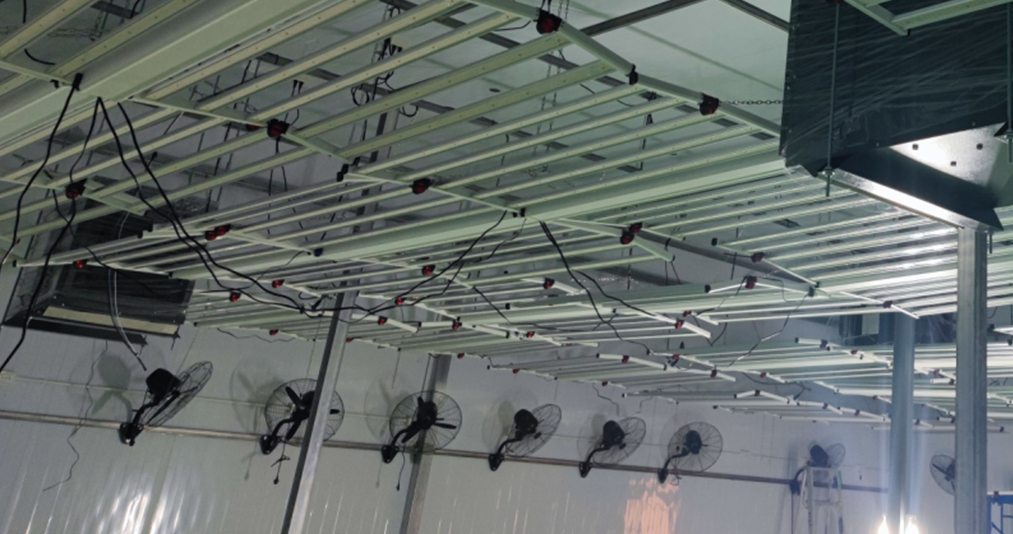THE IMPORTANCE OF PROPER LIGHTING IN CANNABIS CULTIVATION
2023-07-21
Understanding the Role of Light in Cannabis Growth
Photoperiodism and Cannabis
Cannabis is a photoperiodic plant, meaning its growth and flowering stages are influenced by the duration of light and darkness it receives. During the vegetative stage, cannabis plants require longer periods of light (usually 18-24 hours) to encourage vegetative growth and the development of healthy foliage. In contrast, the flowering stage requires a shift to a shorter light cycle (usually 12 hours of light and 12 hours of darkness) to trigger the onset of flowering.
Proper manipulation of light duration and intensity is essential to ensure cannabis plants transition smoothly between these growth stages, ultimately maximizing their potential.
The Importance of Photosynthesis
Photosynthesis, the process by which plants convert light energy into chemical energy, is a fundamental process for cannabis growth. Light is absorbed by specialized pigments called chlorophyll within the plant's cells, providing the energy necessary for photosynthesis to occur.
During photosynthesis, plants convert carbon dioxide (CO2) and water (H2O) into glucose (sugar) and oxygen (O2). Glucose serves as the primary energy source for plant growth, while oxygen is released into the atmosphere.
Proper lighting conditions, including the right spectrum, intensity, and duration, optimize the photosynthesis process, allowing cannabis plants to produce and store the energy necessary for healthy growth, robust flowering, and abundant resin production.
Choosing the Right Light Spectrum
Understanding Light Spectrum
Light is composed of different wavelengths, each corresponding to a specific color. The spectrum of light can be divided into different color ranges, including red, blue, green, and others. These colors have varying effects on plant growth and development.
The Impact of Different Light Colors on Cannabis
-
Red Light: Red light in the spectrum (around 620-780 nanometers) plays a crucial role in promoting flowering and fruiting in cannabis. It stimulates the production of hormones necessary for the transition from the vegetative stage to the flowering stage.
-
Blue Light: Blue light (around 400-520 nanometers) is essential for the vegetative growth of cannabis. It influences the structure, shape, and overall health of plants, promoting compact growth, strong stems, and vibrant foliage.
-
Other Light Colors: While red and blue lights are most important for cannabis growth, other colors within the spectrum, such as green and far-red, also have subtle effects on plant development. However, their contribution is relatively smaller compared to red and blue light.
Finding the right balance of light colors and providing the appropriate spectrum for each growth stage is vital for optimal cannabis cultivation.
Light Intensity and Duration
Finding the Optimal Light Intensity
Light intensity refers to the amount of light that reaches the cannabis plants' surface. The appropriate light intensity depends on the growth stage and the specific cultivar being grown.
During the vegetative stage, cannabis plants generally thrive under higher light intensities, ranging from 400 to 600 micromoles per square meter per second (μmol/m²/s). This promotes vigorous growth, strong stems, and healthy foliage.
In the flowering stage, slightly lower light intensities of around 600 to 800 μmol/m²/s are usually sufficient to support bud development and resin production.
Understanding Photoperiods and Light Cycles
Cannabis plants require specific light and dark cycles to regulate their growth and flowering. During the vegetative stage, providing 18-24 hours of light promotes continuous growth and development. This extended photoperiod mimics the long days of summer, encouraging the plant to focus on vegetative growth.
When transitioning to the flowering stage, it is crucial to reduce the light cycle to 12 hours of light and 12 hours of uninterrupted darkness. This triggers the plant's hormonal response, initiating the flowering process.
Maintaining consistent light cycles throughout the growth cycle is crucial for optimal plant development and preventing stress-induced issues.
Types of Lighting Systems
High-Intensity Discharge (HID) Lights
HID lights, such as metal halide (MH) and high-pressure sodium (HPS) lights, have long been popular choices for cannabis cultivation. MH lights emit a bluish spectrum, ideal for the vegetative stage, while HPS lights emit a reddish spectrum, suitable for the flowering stage.
HID lights are known for their high light output and intensity, making them suitable for larger grow spaces. However, they consume more energy and produce significant heat, requiring proper ventilation and cooling systems.
Light-Emitting Diodes (LED) Lights
LED lights have gained popularity in recent years due to their energy efficiency, versatility, and customizable spectrum. LED grow lights are available in a wide range of spectrums, allowing growers to tailor the light to specific growth stages and cultivars.
LED lights are known for their longevity, low heat output, and reduced energy consumption compared to HID lights. They also offer the advantage of being more compact, making them suitable for smaller grow spaces or vertical farming setups.
Fluorescent Lights
Fluorescent lights, particularly T5 fluorescent tubes, are commonly used for seedlings, clones, and early vegetative growth. They provide a cool and uniform light spectrum, promoting healthy root development and initial growth stages.
Fluorescent lights are energy-efficient, emit less heat, and can be placed closer to the plants without causing light burn. However, they have lower light intensity compared to HID or LED lights, making them less suitable for the flowering stage.
Light Positioning and Distribution
Achieving Uniform Light Distribution
Proper light distribution is essential to ensure even growth and development throughout the cannabis canopy. Light should reach all parts of the plant, including lower foliage and buds, to prevent lanky growth and encourage bud development.
Using reflectors or light movers can help distribute light more evenly and maximize its penetration into the plant canopy. Reflective materials, such as Mylar or white paint, can be applied to walls or grow tents to enhance light reflection.
Avoiding Light Burn and Shadowing
Proper light positioning is crucial to avoid light burn or damage to the plant's leaves and buds. Placing lights too close to the plants can cause heat stress and light burn, while positioning them too far can result in insufficient light intensity and stretching of the plants.
Additionally, avoiding shadowing is important to ensure all parts of the plant receive adequate light. Pruning and training techniques, such as topping or LST (low-stress training), can help create an open and evenly exposed canopy.
Energy Efficiency and Cost Considerations
Choosing Energy-Efficient Lighting Systems
Energy efficiency is a significant consideration in cannabis cultivation, as lighting can account for a significant portion of energy consumption. Opting for energy-efficient lighting systems, such as LED lights, can help reduce electricity costs and minimize the environmental footprint of cultivation operations.
LED lights have higher energy efficiency compared to HID lights, as they convert a higher percentage of electrical energy into usable light. This results in less heat generation and lower energy waste.
Calculating and Managing Energy Consumption
To manage energy consumption effectively, it is essential to calculate the total power requirements of the lighting system and consider the cost per kilowatt-hour (kWh) of electricity. This information can help optimize lighting schedules and make informed decisions regarding lighting upgrades or adjustments.
Using timers or automated lighting systems can also help regulate light cycles and prevent unnecessary energy consumption.
Light Management Techniques
Light Movers and Reflective Materials
Light movers are mechanical devices that move the lighting fixtures along a rail system, providing a more uniform light distribution. They ensure that all areas of the grow space receive equal exposure to light, preventing uneven growth and maximizing yield potential.
Using reflective materials, such as Mylar, aluminum foil, or white paint, can help redirect and intensify light by bouncing it back onto the plants. Applying reflective materials to walls, ceilings, or grow tents can significantly enhance light distribution and efficiency.
Canopy Management and Training Techniques
Proper canopy management techniques, such as topping, pruning, or employing techniques like SCROG (screen of green) or trellising, can help ensure even light penetration and bud development throughout the plant canopy. These techniques encourage the growth of multiple main colas and discourage lanky growth, maximizing light absorption and yield potential.
Regular monitoring and adjustment of the canopy height and shape allow for better light utilization and improved overall plant health.
Common Lighting Mistakes to Avoid
Overexposure to Light
Providing excessive light can cause stress and damage to cannabis plants. Light burn, characterized by bleaching or burning of leaves and buds, can result from intense light sources placed too close to the plants. Maintaining appropriate light intensity and distance is essential to avoid this issue.
Poor Light Quality or Spectrum
Using lighting systems with incorrect light spectrums for specific growth stages can lead to suboptimal plant growth and reduced yields. Understanding the light requirements of cannabis at different stages is crucial for selecting appropriate lighting systems.
Inconsistent Light Cycles
Maintaining consistent light cycles is crucial for cannabis cultivation. Inconsistent light periods can disrupt the plant's hormonal balance, leading to stress, delays in flowering, or hermaphroditism. Strict adherence to light schedules is essential for successful growth and flowering.
The Future of Lighting in Cannabis Cultivation
Advancements in LED Technology
The field of LED technology continues to advance rapidly, with improvements in efficiency, spectrum customization, and light output. Researchers and manufacturers are constantly developing new LED models that provide optimal light spectrums for cannabis growth, resulting in higher yields and improved quality.
Sustainable and Eco-Friendly Lighting Solutions
The push for sustainable and eco-friendly cultivation practices has also influenced lighting advancements. Energy-efficient lighting systems, such as LEDs, help reduce energy consumption and carbon footprint. Additionally, renewable energy sources, such as solar panels or wind turbines, can be integrated into lighting systems to further minimize environmental impact.
Proper lighting is a fundamental aspect of successful cannabis cultivation. By understanding the role of light in cannabis growth, choosing the right light spectrum, managing light intensity and duration, selecting appropriate lighting systems, and employing effective light management techniques, cultivators can optimize their yields, enhance resin production, and produce high-quality cannabis products.
Investing in efficient lighting systems, monitoring light cycles and intensity, and implementing sustainable practices will not only benefit cannabis cultivators but also contribute to a more environmentally conscious industry.
As the cannabis industry continues to evolve, proper lighting practices will remain an integral part of successful cultivation, supporting the growth and development of healthy and robust cannabis plants.







